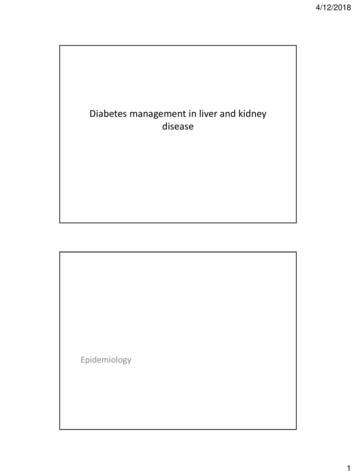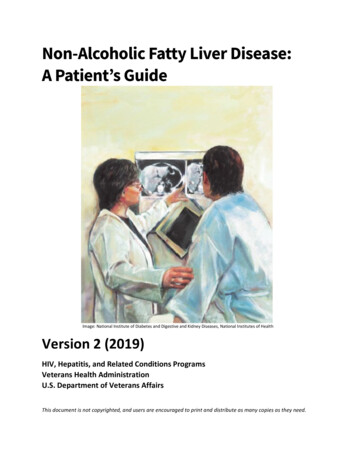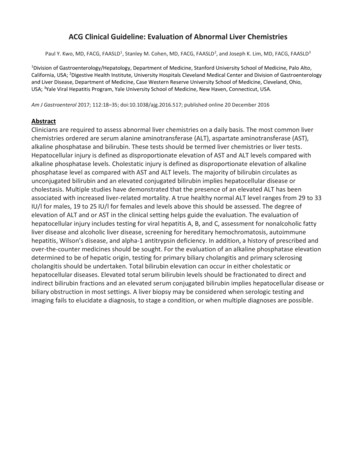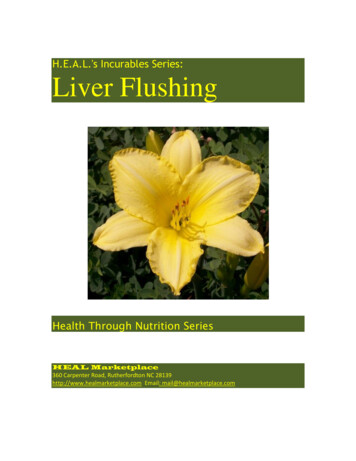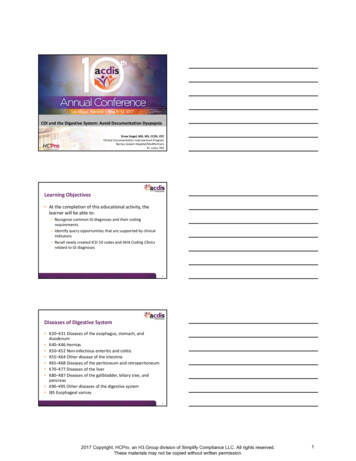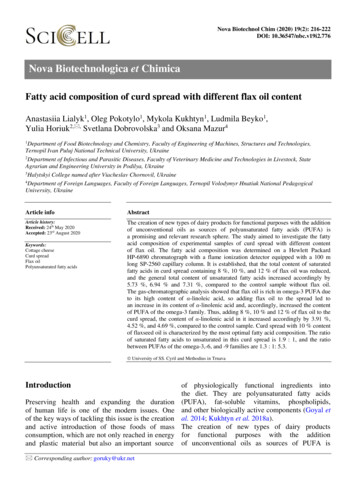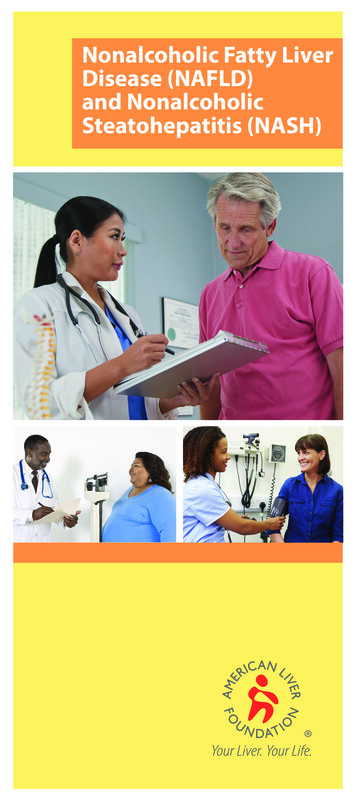
Transcription
Nonalcoholic Fatty LiverDisease (NAFLD)and NonalcoholicSteatohepatitis (NASH)
Why is your liver important?You cannot live without your liver. Locatedunder your rib cage on your right side, the liveris the largest internal organ in the body. Itweighs about three pounds and is shaped like afootball that is flat on one side. Among its manyimportant functions are: Cleaning your blood of toxins Giving you energy Producing bile for digestion Processing what you eat and drink intonutrients your body can useFiltering out harmful substances fromyour blood What is NonalcoholicFatty Liver Disease?While it is normal for the liver to contain somefat, too much fat can cause liver damage andcomplications. When fat makes up more thanfive to ten percent of the liver’s weight, it iscalled Fatty Liver Disease. The most commoncauses of Fatty Liver Disease are excess weight/obesity and unhealthy alcohol use. Othercauses of Fatty Liver Disease include but arenot limited to medications and Wilson Disease.If the extra fat is not caused by high alcoholconsumption, it is called Nonalcoholic FattyLiver Disease (NAFLD).Do many people haveNonalcoholic Fatty Liver Disease?Yes. NAFLD affects many adults and children.It is the most common cause of chronic liverdisease in the United States. This disease affectsup to 25 percent of the world’s population.1Nonalcoholic Fatty Liver Disease (NAFLD)
NORMAL LIVERFATTY LIVERPROGRESSION OFNAFLDCIRRHOSISNASHWhat is NonalcoholicSteatohepatitis?Nonalcoholic steatohepatitis (NASH) is a severeform of Fatty Liver Disease. “Steato” means fatand “hepatitis” means inflammation (swelling) of the liver. Like NAFLD and many otherliver disorders, NASH can be asymptomaticand progress undetected for a long time. Inadvanced stages of the disease, NASH can result in fibrosis (scarring of the liver), cirrhosis(permanent scarring and hardening of the liver), liver cancer and liver failure.How many people with NAFLDdevelop NASH?Experts estimate that about 20 percent ofpeople with NAFLD will develop NASH.What are some of the risk factorsfor NAFLD and NASH?Being overweight or obese Type 2 diabetes or prediabetes High cholesterol High levels of triglycerides High blood pressure Abdominal distribution of body fat Nonalcoholic Fatty Liver Disease (NAFLD)2
How are NAFLD and NASHdiagnosed?Doctors will first review your medicalhistory and do a physical exam. As part of thephysical exam, they will likely check your heightand weight to determine your Body MassIndex (BMI). This is a measure of a person’sbody fat. Doctors may also perform blood teststo see if your liver enzymes are higher thannormal. Two of the most common liver enzymesare alanine transaminase (ALT) and aspartatetransaminase (AST). Additional tests for diabetesand to measure the amount of cholesteroland triglycerides in your blood may also beperformed, along with tests for other causes ofliver inflammation.To find out whether there is fat build-up in yourliver, your doctor may request imaging testssuch as an ultrasound, magnetic resonance imaging (MRI) or computed tomography (CT) scan.To learn if you have fibrosis, liver stiffness tests(elastography) or a liver biopsy may be needed.What can help prevent NAFLD andNASH?A healthy diet and active lifestyle can helpprevent NAFLD and NASH. It is recommendedthat people at risk for and/or living with NAFLDor NASH limit the consumption of processedfoods or foods with a high sugar content. Better choices are fruits, vegetables, whole grainsand low-fat dairy products. These foods areeasier for the liver to process and for the bodyto convert into energy. Reducing or eliminating alcohol is also suggested, because alcoholis toxic for the liver and encourages fat to enter the liver. In addition, it is a good idea to talkto your doctor about what vitamin and mineralsupplements to take, and to exercise for 30 to 603Nonalcoholic Fatty Liver Disease (NAFLD)
minutes most days. If you have excess body fat,your doctor may suggest a gradual weight lossprogram so you can reduce your overall weightby at least 10 percent. Drinking one to two cupsof unsweetened, caffeinated coffee a day mayalso be beneficial.Food Choices andFood Preparation Tips1. Prepare your own meals. This is the bestway to keep track of every ingredient inyour food.2. Cook with unrefined fats and oils, suchas olive and nut oils.3. Eat balanced meals. See the colors ofthe rainbow on your plate.4. Add oily fish such as salmon, and nutssuch as walnuts to your diet. Foods likethese that are high in omega-3 fattyacids have many health benefits.5. Consume fewer high-glycemic indexfoods, such as white bread, rice andpotatoes. These foods can cause rapidchanges in your blood sugar level.6.Try to avoid junk food, fast food, friedfood, fatty food and sugary drinks. Ingeneral, these foods lack the nutrientsnecessary to keep your body energizedand healthy.Nonalcoholic Fatty Liver Disease (NAFLD)4
7. Stay hydrated by drinking plenty ofwater and seltzer, plus coffee and tea inmoderation.8. Measure the size of your portions. Tryswapping your usual plate, bowl orserving utensils for smaller alternatives.Also, try having a glass of water up to 30minutes before a meal to help fill you up.9. Exercise regularly. The best exerciseprogram is one you stick to! Alwaysspeak to your doctor before engaging inany new exercise routine.10. Beer and wine can be just as dangerousfor the liver as hard liquor. Rememberthat there is no safe level of alcoholconsumption if you already have liverdamage.Are there medicines that cureNAFLD and NASH?Although researchers are studyingpotential medications, there are currently nomedications available to cure NAFLD and NASH.Recommended treatment for most peopleconsists of slow and steady weight loss. It isgenerally advised to try to lose one pound perweek. Losing too much weight too quickly cancause further liver damage.If you have NASH with cirrhosis, doctors cantreat the health problems caused by thecirrhosis with medicines and medicalprocedures. Liver transplantation may be neededfor some patients.5Nonalcoholic Fatty Liver Disease (NAFLD)
NotesNonalcoholic Fatty Liver Disease (NAFLD)6
American Liver 465-4837)/Liverinfo/LiverUSA/AmericanLiverThis brochure was made possible, in part, through the generoussupport of Pfizer Inc. and Bristol Myers Squibb. The AmericanLiver Foundation is solely responsible for its content. 2020 American Liver Foundation. All rights reserved.
such as walnuts to your diet. Foods like these that are high in omega-3 fatty acids have many health benefits. 5. Consume fewer high-glycemic index foods, such as white bread, rice and potatoes. These foods can cause rapid changes in your blood sugar level. 6. Try to avoid junk food, fast food, fried food, fatty food and sugary drinks. In
